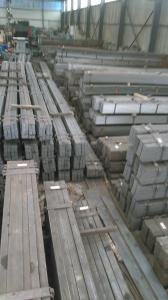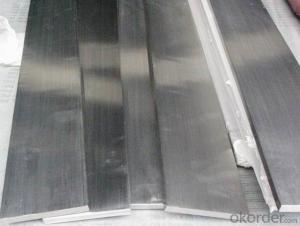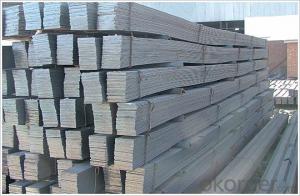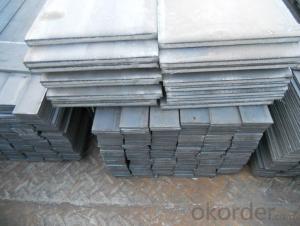Flat Bulb Bar Steel Ball From 12# To 22#
- Loading Port:
- China main port
- Payment Terms:
- TT or LC
- Min Order Qty:
- 50 m.t.
- Supply Capability:
- 5000 m.t./month
OKorder Service Pledge
OKorder Financial Service
You Might Also Like
Commodity: Carbon Steel Flat Bar
Standard: GB, JIS, ASTM,
Material: Q235, SS400 or Equivalent
Origin place: China
Thickness: 3mm-30mm
Width:20mm-200mm
Length: Max 12m
Certification: SGS/BV
Chemical composition
Alloy No | Grade | Element(%) | ||||
C | Mn | S | P | Si | ||
Q235 | B | 0.12—0.20 | 0.3—0.7 | ≤0.045 | ≤0.045 | ≤0.3 |
Physical properties
Alloy No | Grade | Yielding strength point(Mpa) | Tensile strength (Mpa) | Elongation after fracture(%) | ||||||
Thickness (mm) | Thickness (mm) | |||||||||
≤16 | >16--40 | >40--60 | >60--100 | ≤16 | >16--40 | >40--60 | >60--100 | |||
≥ | ≥ | |||||||||
Q235 | B | 235 | 225 | 215 | 205 | 375--500 | 26 | 25 | 24 | 23 |
Usage/Applications of Flat Bar
Widely used for construction;
Machinery manufacturing;
Iron tower steel structure;
Shipbuilding; Steel grating;
Staircase;
Bridge;
Viaduct;
Railway spare parts;
Boilers making etc.
Packaging & Delivery
Packaging Details: The Steel Flat Bars are packed in bundles and loaded in 20 feet/40 feet container, or shipped by bulk cargo ,also we can do as customer's requirements.
Delivery Details:30~45 days upon the receipt of buyer payment by T.T. or L/C.
Production Flow
The Carbon Steel Flat Bar is made through three processes:
1.Feeding the material: Feeding the row material (the steel plate) to Slitting Line.
2.Slitting:The steel plate would be slitted into expected width by lengthways cutter.
3. Leveled and cutting: The plat bar would be ground into level by the grinder and then cut into required length.
FAQ:
Q1: Why buy Materials & Equipment from OKorder.com?
A1: All products offered byOKorder.com are carefully selected from China's most reliable manufacturing enterprises. Through its ISO certifications, OKorder.com adheres to the highest standards and a commitment to supply chain safety and customer satisfaction.
Q2: What makes stainless steel stainless?
A2: Stainless steel must contain at least 10.5 % chromium. It is this element that reacts with the oxygen in the air to form a complex chrome-oxide surface layer that is invisible but strong enough to prevent further oxygen from "staining" (rusting) the surface. Higher levels of chromium and the addition of other alloying elements such as nickel and molybdenum enhance this surface layer and improve the corrosion resistance of the stainless material.
Q3: Can stainless steel rust?
A3: Stainless does not "rust" as you think of regular steel rusting with a red oxide on the surface that flakes off. If you see red rust it is probably due to some iron particles that have contaminated the surface of the stainless steel and it is these iron particles that are rusting. Look at the source of the rusting and see if you can remove it from the surface.
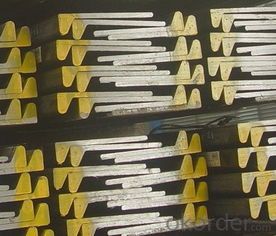
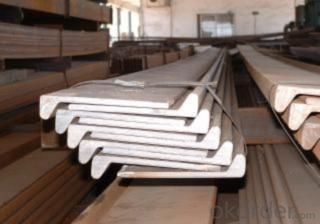
- Q:Can steel flat bars be cold-formed or bent?
- Yes, steel flat bars can be cold-formed or bent. Cold-forming or bending is a process that involves shaping the metal at room temperature without the use of heat. Steel flat bars are commonly cold-formed or bent to create various shapes, angles, or curves to suit specific applications and designs. The process typically involves using specialized machinery such as press brakes or rollers to exert force on the steel flat bar, causing it to deform and take on the desired shape. Cold-forming or bending steel flat bars allows for precise customization and flexibility in design, making them suitable for a wide range of industries and applications such as construction, manufacturing, and engineering.
- Q:Do steel flat bars have a specific yield strength?
- Yes, steel flat bars do have a specific yield strength. Yield strength is the amount of stress that a material can withstand before it begins to deform permanently. The yield strength of steel flat bars is determined by the grade or type of steel used in their manufacturing. Different grades of steel have different yield strengths, which are typically measured in pounds per square inch (psi) or megapascals (MPa). For example, a common grade of steel used for flat bars, such as ASTM A36, has a yield strength of 36,000 psi or 250 MPa. It is important to consider the specific yield strength of steel flat bars when selecting them for structural or load-bearing applications, as it determines their ability to withstand forces without permanent deformation.
- Q:Can steel flat bars be used for manufacturing architectural facades or cladding?
- Architectural facades or cladding can be manufactured using steel flat bars, which are versatile and durable. Steel is a popular choice due to its strength and aesthetic appeal. These flat bars can be easily shaped and fabricated to meet specific design requirements, making them suitable for various architectural applications. There are several advantages to using steel flat bars for architectural facades or cladding. Firstly, steel offers excellent structural properties, providing stability and resistance against external forces like wind or seismic activity. This makes it a dependable option for buildings that require a strong and sturdy exterior. Furthermore, steel flat bars can be finished in different ways to enhance their visual appeal. They can be painted, powder coated, or left untreated for an industrial look. Steel's natural gray or metallic appearance can complement a wide range of architectural styles, from modern to traditional. Additionally, steel flat bars are highly resistant to corrosion and weathering, making them ideal for exterior applications. With proper maintenance, steel facades or cladding can withstand harsh weather conditions and maintain their appearance for many years. However, it is crucial to consider specific project requirements and consult with architects, engineers, and manufacturers to ensure that the chosen steel flat bars meet the necessary specifications and standards for architectural facades or cladding.
- Q:Can steel flat bars be drilled?
- Yes, steel flat bars can be drilled. Steel is a versatile and strong material that can be easily drilled through using appropriate drill bits and drilling techniques. It is important to select the right type of drill bit for drilling steel, such as a high-speed steel (HSS) or cobalt drill bit, as these are designed to withstand the hardness of steel. Additionally, lubricating the drilling area with cutting fluid or oil can help reduce friction and heat buildup during the drilling process. Proper drilling techniques, including using moderate pressure and maintaining a steady drilling speed, will ensure accurate and efficient drilling in steel flat bars.
- Q:What are the advantages of using steel flat bars in construction?
- There are several advantages of using steel flat bars in construction. Firstly, steel flat bars offer exceptional strength and durability, making them suitable for supporting heavy loads and withstanding harsh weather conditions. Secondly, steel flat bars are highly versatile and can be easily shaped and manipulated to fit various construction requirements, allowing for greater design flexibility. Additionally, steel flat bars have excellent fire resistance properties, providing increased safety in case of a fire. Lastly, steel is a sustainable and recyclable material, making it an environmentally friendly choice for construction projects.
- Q:Can steel flat bars be used in the marine industry?
- Yes, steel flat bars can be used in the marine industry. Steel is a commonly used material in maritime applications due to its high strength, durability, and resistance to corrosion. Steel flat bars can be utilized for various purposes such as structural frameworks, support beams, and reinforcement in marine vessels, offshore platforms, and other marine structures. Additionally, steel can be coated or treated to further enhance its resistance to saltwater corrosion, making it suitable for marine environments.
- Q:Can steel flat bars be used in electrical or electronic equipment?
- Yes, steel flat bars can be used in electrical or electronic equipment, especially in applications that require structural support, grounding, or electromagnetic shielding. However, it is important to note that steel may not be suitable for components or areas where insulation or non-magnetic properties are required.
- Q:Are steel flat bars available in custom sizes?
- Yes, steel flat bars are available in custom sizes.
- Q:Can steel flat bars be used for making brackets or supports for power generation equipment?
- Certainly, brackets or supports for power generation equipment can be made using steel flat bars. Steel, a sturdy and long-lasting material, is widely employed in the construction of diverse industrial machinery, including power generation systems. Steel flat bars provide remarkable strength and rigidity, rendering them suitable for supporting heavy loads and enduring the challenging operational conditions often encountered in power generation facilities. Additionally, steel is renowned for its corrosion resistance, a crucial characteristic for equipment exposed to moisture or harsh environments. In summary, steel flat bars are a dependable option for fabricating brackets or supports for power generation equipment due to their strength, durability, and resistance to corrosion.
- Q:What is a steel flat bar?
- A steel flat bar is a long, rectangular-shaped metal bar that is made of steel. It has a flat surface and is typically used in construction, manufacturing, and engineering applications. The flat shape of the bar allows for easy fabrication and installation in various projects. Steel flat bars are versatile and can be used in structural supports, braces, frames, and as reinforcement in concrete structures. They are available in different sizes, thicknesses, and lengths to suit specific requirements. Steel flat bars are known for their strength, durability, and resistance to corrosion, making them a popular choice in many industries.
1. Manufacturer Overview |
|
|---|---|
| Location | |
| Year Established | |
| Annual Output Value | |
| Main Markets | |
| Company Certifications | |
2. Manufacturer Certificates |
|
|---|---|
| a) Certification Name | |
| Range | |
| Reference | |
| Validity Period | |
3. Manufacturer Capability |
|
|---|---|
| a)Trade Capacity | |
| Nearest Port | |
| Export Percentage | |
| No.of Employees in Trade Department | |
| Language Spoken: | |
| b)Factory Information | |
| Factory Size: | |
| No. of Production Lines | |
| Contract Manufacturing | |
| Product Price Range | |
Send your message to us
Flat Bulb Bar Steel Ball From 12# To 22#
- Loading Port:
- China main port
- Payment Terms:
- TT or LC
- Min Order Qty:
- 50 m.t.
- Supply Capability:
- 5000 m.t./month
OKorder Service Pledge
OKorder Financial Service
Similar products
New products
Hot products
Related keywords




















